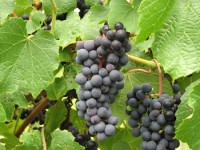Event Details
Date
November 2, 2016
Time
8:30am-3:30pm
Location
WebEx Webinar
Cost
This event is free.
Host
Cornell University
CRAVE Conference: Cornell Recent Advances in Viticulture and Enology
November 2, 2016
The annual CRAVE (Cornell Recent Advances in Viticulture and Enology) conference features 15 minute presentations by Cornell faculty, extension associates, and graduate students on current extension and research topics of their choice. For this year's conference, we would like to invite you to log on for as little or as much time as you want to hear cutting-edge presentations about viticulture, enology, economics and more. Find out what Cornell Research and Extension faculty and staff have been up to this past year.
To Attend:
WebEx: The entire program will be broadcasted as an online webinar you can access through your computer. To join the webinar, simply click on this link:
https://cornell.webex.com/cornell/j.php?MTID=m4ae206771589f33bfe2331ca1e954b7e
And type in the password: Grape2016
Meeting number: 642 390 320
Meeting password: Grape2016
Then follow instructions to join the ‘audio conference'. You will hear the speakers' audio and see their slides. You may also ask questions by typing them in at the ‘Chat bar'.
Topics include…
8:30 AM - 10:00 AM
· Deacclimation rates of cultivated and wild grapes (USDA-ARS Londo Program)
· Epidemiology of Grapevine Red Blotch (Fuchs Program)
· Economic impact of National Clean Plant Network Programs (Gomez Program)
· How wine characteristics and consumer knowledge affect wine purchase decisions (Gomez Program)
· Wrap-up of SCRI Vitis-Gen Project (Reisch Program)
· Implementing variable rate management in Concord Vineyards (Bates Program)
10:30 AM - Noon
· Genetics of Grape Leaf Morphology (Demming, Reisch Program)
· Native yeast strains in unenoculated Riesling fermentations in the Finger Lakes (Mansfield and Kao-Kniffen programs)
· Etiology and management of sour rot (Wilcox Program)
· Pallisage - an alternative to mechanical hedging in Vinifera vineyards (Vanden Heuvel program)
· Pre-fermentation removal of proteins increases tannin extraction (Sacks Program)
· A sustainable practices workbook for wineries (Gerling Program)
2:00 PM - 3:30 PM
· Promotional Video for Grape and Wine Extension Teams (Martinson Program)
· Perception of Sauvignon Blanc Aroma: Defining Quality (Acree Program)
· Copper oxidation state and ability of copper fining to control release of H2S (Sacks Program)
· Climate-Smart Farming: Introduction to Decision Tools (Haggerty, LERGP program)
· Northern Grapes: Five years of field studies with Marquette and Frontenac. (Martinson Program)













































